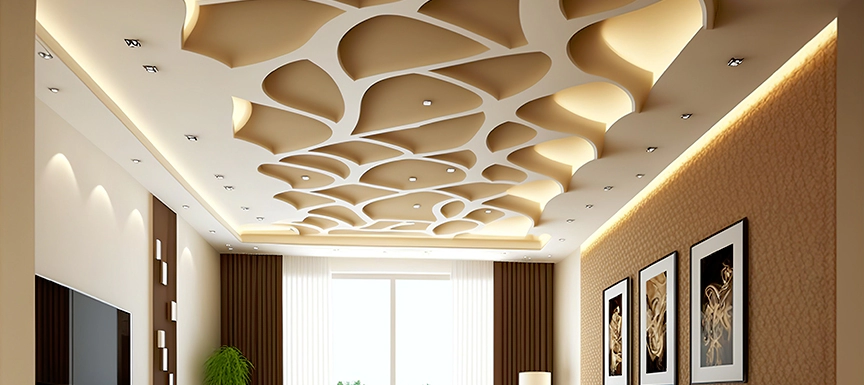Table of Contents
1. Introduction
Modern interior design extends far beyond walls and floors. False ceilings have become a staple in residential interiors, delivering aesthetic appeal and functional advantages. Whether you choose the artistic flexibility of Plaster of Paris (POP) or the sleek functionality of gypsum, understanding these materials' properties can transform your home's ambiance.
This blog explores the technical aspects of POP and gypsum ceilings, provides cost comparisons, and offers advanced design concepts tailored to modern interiors.
2. What Are False Ceilings?
False ceilings, also known as drop ceilings or suspended ceilings, are secondary layers installed below the structural ceiling. Designed to conceal electrical wiring, ductwork, or lighting fixtures, they also improve thermal and acoustic insulation while enhancing the overall design aesthetic.
Technically, false ceilings reduce the ceiling height, which can make a large room feel cozier while maintaining energy efficiency by reducing the volume of air-conditioned space.
3. Types of Materials for False Ceilings
Plaster of Paris (POP)
Chemical Composition: POP is derived from gypsum by heating it to 150°C, where water is expelled to form calcium sulfate hemihydrate.
Characteristics: It forms a paste when mixed with water, which hardens into a durable structure. POP is highly malleable, making it suitable for detailed carvings and complex shapes.
Applications: Frequently used for cornices, intricate molding, and unique artistic ceilings in bedrooms or living rooms.

Gypsum
Chemical Composition: Gypsum boards consist of calcium sulfate dihydrate, pre-mixed with additives to improve moisture and fire resistance.
Characteristics: Manufactured in factories as large panels, they provide a consistent, smooth finish with minimal joints. Gypsum boards are inherently lightweight yet sturdy.
Applications: Ideal for clean, minimalistic designs in contemporary homes or for quick installation in large areas.
4. Technical Comparison: POP vs. Gypsum False Ceilings
Feature | Plaster of Paris (POP) | Gypsum |
Material State | Powder mixed on-site into a paste | Pre-fabricated boards |
Flexibility | Extremely moldable, suitable for artistic and intricate designs | Limited flexibility; best for straight-line and uniform patterns |
Installation Time | Time-intensive; requires skilled labor and proper curing time | Quick and hassle-free; factory-made boards assembled on-site |
Durability | Long-lasting but prone to cracks in humid conditions | Highly durable; resistant to moisture and mildew |
Fire Resistance | Moderate fire resistance | Enhanced fire resistance due to additives |
Weight | Lightweight; easy to install in delicate structures | Slightly heavier but manageable with metal frameworks |
Thermal Insulation | Good insulator; reduces heat penetration in warmer climates | Excellent; often preferred in energy-efficient designs |
5. Pricing Analysis
Material | Base Material Cost (₹ per Sq. Ft.) | Labor Cost (₹ per Sq. Ft.) | Overall Expense (₹ per Sq. Ft.) |
POP | ₹50–₹100 | ₹20–₹50 | ₹70–₹150 |
Gypsum | ₹120–₹200 | ₹50–₹80 | ₹170–₹280 |
Pro Tip: The cost of gypsum may seem higher, but its faster installation and moisture resistance can offset maintenance costs over time.
6. Benefits of False Ceilings
For POP Ceilings:
Malleability: Craft intricate designs for living rooms, dining spaces, and bedrooms.
Cost Efficiency: POP is an affordable option, especially for large spaces.
Thermal Regulation: Acts as a barrier against external heat and cold.
Soundproofing: Reduces noise transmission for quieter interiors.
For Gypsum Ceilings:
Seamless Finish: Offers a professional, polished appearance.
Moisture Resistance: Ideal for bathrooms and kitchens, preventing fungal growth.
Ease of Installation: Pre-fabricated panels speed up project timelines.
Fire Retardant: Enhances safety in high-risk areas.
7. Advanced Ceiling Design Concepts
Coffered Patterns: Add depth and texture using recessed panels arranged in a grid.
Floating Ceilings: Incorporate hidden LED strips for a futuristic floating effect.
Mixed Material Ceilings: Combine POP with metal or wooden inlays for a dynamic look.
Vaulted Ceilings: Perfect for large rooms; enhances vertical space.
Eco-Friendly Finishes: Use low-VOC paints or recycled gypsum boards for sustainable designs.
8. Maintenance Guide for POP and Gypsum Ceilings
POP Maintenance Tips:
Ensure proper sealing during installation to prevent cracks.
Use water-resistant paints to prolong lifespan in humid areas.
Gypsum Maintenance Tips:
Clean with dry cloths; avoid excessive moisture exposure.
Inspect metal frameworks periodically to prevent rust or sagging.
Insight: Regular inspections and prompt repairs extend the lifespan of both materials.
9. Conclusion
Both POP and gypsum ceilings bring distinct advantages, catering to different aesthetic and functional requirements. POP excels in creative customization, while gypsum stands out for its practicality and durability. Choosing the right material depends on your priorities, budget, and the specific needs of your space.
Explore More with Pescora Design
Looking for expert advice on false ceilings? Visit Pescora Design for tailored solutions that blend style and functionality seamlessly. Let us transform your ceilings into statement-making masterpieces!







Comments